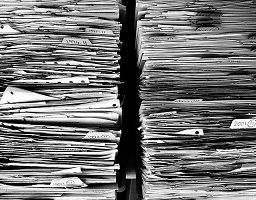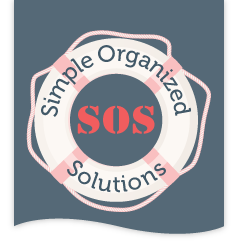 I see this so much with my older clients. Most, if not all of them have a huge paperwork backlog. I get it, I really do. As I was growing up, even though I didn’t notice at the time, my parents were collecting paperwork.
I see this so much with my older clients. Most, if not all of them have a huge paperwork backlog. I get it, I really do. As I was growing up, even though I didn’t notice at the time, my parents were collecting paperwork.
There were invoices, utility bills, cancelled checks – yes, our cancelled checks were actually returned to us in our monthly bank statements, investment statements, all types of insurance bills/statements, medical bills/statements, etc.
The incoming flow of paper was relentless! Pretty much anything paper-related came to us via the US Postal Service, business and personal. Not only the paper from the service providers we hired, we also received newspapers, greeting cards, ads, newsletters, you name it, we got it in the mail. It’s no wonder we ended up with a paperwork backlog.
We were taught to keep receipts in case we needed them someday. Back in the day we didn’t have the guidelines we have today for keeping important papers. That’s really the concern, what do we keep, and how do we safely destroy the important papers we discard. Things are very different today. Fast forward to today’s digital world.
These days we are told to avoid getting physical paperwork to help protect the planet. Go green-reduce, reuse, recycle. We have the means to keep our paperwork minimal in this age of digital, via electronic devices. The companies we do business with have the capability of providing us with information online, thus eliminating the need to keep a lot of paperwork.
Doing business online, and communicating online, can help cut off the incoming flow of paperwork, but what do we do with the paperwork backlog?
Fortunately, there are options, to manage a paperwork backlog. Check out the options below to see if any of them will work for you.
Options to Manage a Paperwork Backlog
DIY
If you choose this option, take it in small chunks, or you will get burnt out quickly.
Set up a workspace with a shredder, recycle bin, trash can, marker and sticky notes.
Start on a small stack of paperwork, maybe while you’re watching tv.
As you go through each piece, make a decision to keep or discard.
If the piece of paper needs to be discarded and has personal information on it, such as an account number or social security number, it needs to be shredded. If not, it can go into the recycle bin. NOTE: Staples and paper clips can go into the recycle bin. Staples can be shredded but please remove paperclips.
Use the sticky notes and marker to create categories for the paperwork you intend to keep. This will make filing them into your file system quick and easy.
Hire Services
Ok, now I’m putting on my professional organizer hat to share with you how we can help you make your paperwork backlog disappear.
The first step is probably the most painful one in this process but it must be done. An organizer will gather all your paperwork together. Then as you look at each piece to make the keep or toss decision, an organizer with put it in the correct keep or toss category.
The decision to toss has a couple of subcategories – recycle and shred. Recycling can go right into your bin if you recycle. Important papers need to be shredded, and if you have a large volume to shred, hiring a service is the way to go.
Some services will come to your home and shred it onsite, or pick it up and take it back to their facility to shred.
There are other services where you take it to them and they shred it in house. The difference between the services is the cost. When you take it to them, it’s less expensive and they charge by the pound. Onsite pickup service, or shredding it at your home is more expensive.

